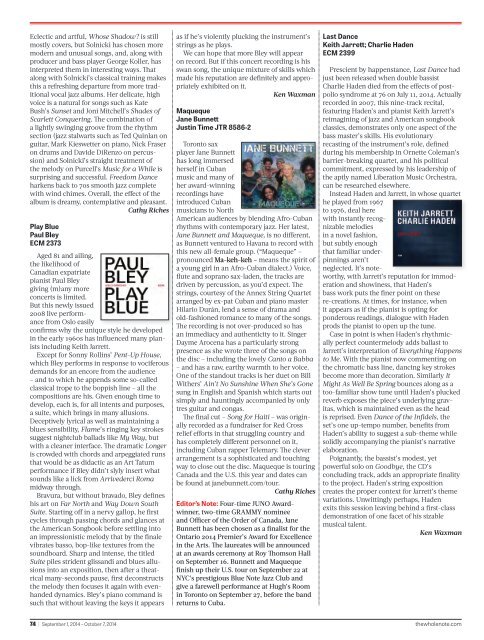You also want an ePaper? Increase the reach of your titles
YUMPU automatically turns print PDFs into web optimized ePapers that Google loves.
Eclectic and artful, Whose Shadow? is stillmostly covers, but Solnicki has chosen moremodern and unusual songs, and, along withproducer and bass player George Koller, hasinterpreted them in interesting ways. Thatalong with Solnicki’s classical training makesthis a refreshing departure from more traditionalvocal jazz albums. Her delicate, highvoice is a natural for songs such as KateBush’s Sunset and Joni Mitchell’s Shades ofScarlett Conquering. The combination ofa lightly swinging groove from the rhythmsection (jazz stalwarts such as Ted Quinlan onguitar, Mark Kieswetter on piano, Nick Fraseron drums and Davide DiRenzo on percussion)and Solnicki’s straight treatment ofthe melody on Purcell’s Music for a While issurprising and successful. Freedom Danceharkens back to 70s smooth jazz completewith wind chimes. Overall, the effect of thealbum is dreamy, contemplative and pleasant.Cathy RichesPlay BluePaul BleyECM 2373Aged 81 and ailing,the likelihood ofCanadian expatriatepianist Paul Bleygiving (m)any moreconcerts is limited.But this newly issued<strong>20</strong>08 live performancefrom Oslo easilyconfirms why the unique style he developedin the early 1960s has influenced many pianistsincluding Keith Jarrett.Except for Sonny Rollins’ Pent-Up House,which Bley performs in response to vociferousdemands for an encore from the audience– and to which he appends some so-calledclassical trope to the boppish line – all thecompositions are his. Given enough time todevelop, each is, for all intents and purposes,a suite, which brings in many allusions.Deceptively lyrical as well as maintaining ablues sensibility, Flame’s ringing key strokessuggest nightclub ballads like My Way, butwith a cleaner interface. The dramatic Longeris crowded with chords and arpeggiated runsthat would be as didactic as an Art Tatumperformance if Bley didn’t slyly insert whatsounds like a lick from Arrivederci Romamidway through.Bravura, but without bravado, Bley defineshis art on Far North and Way Down SouthSuite. Starting off in a nervy gallop, he firstcycles through passing chords and glances atthe American Songbook before settling intoan impressionistic melody that by the finalevibrates basso, bop-like textures from thesoundboard. Sharp and intense, the titledSuite piles strident glissandi and blues allusionsinto an exposition, then after a theatricalmany-seconds pause, first deconstructsthe melody then focuses it again with evenhandeddynamics. Bley’s piano command issuch that without leaving the keys it appearsas if he’s violently plucking the instrument’sstrings as he plays.We can hope that more Bley will appearon record. But if this concert recording is hisswan song, the unique mixture of skills whichmade his reputation are definitely and appropriatelyexhibited on it.Ken WaxmanMaquequeJane BunnettJustin Time JTR 8586-2Toronto saxplayer Jane Bunnetthas long immersedherself in Cubanmusic and many ofher award-winningrecordings haveintroduced Cubanmusicians to NorthAmerican audiences by blending Afro-Cubanrhythms with contemporary jazz. Her latest,Jane Bunnett and Maqueque, is no different,as Bunnett ventured to Havana to record withthis new all-female group. (“Maqueque” –pronounced Ma-keh-keh – means the spirit ofa young girl in an Afro-Cuban dialect.) Voice,flute and soprano sax-laden, the tracks aredriven by percussion, as you’d expect. Thestrings, courtesy of the Annex String Quartetarranged by ex-pat Cuban and piano masterHilario Durán, lend a sense of drama andold-fashioned romance to many of the songs.The recording is not over-produced so hasan immediacy and authenticity to it. SingerDayme Arocena has a particularly strongpresence as she wrote three of the songs onthe disc – including the lovely Canto a Babba– and has a raw, earthy warmth to her voice.One of the standout tracks is her duet on BillWithers’ Ain’t No Sunshine When She’s Gonesung in English and Spanish which starts outsimply and hauntingly accompanied by onlytres guitar and congas.The final cut – Song for Haiti – was originallyrecorded as a fundraiser for Red Crossrelief efforts in that struggling country andhas completely different personnel on it,including Cuban rapper Telemary. The cleverarrangement is a sophisticated and touchingway to close out the disc. Maqueque is touringCanada and the U.S. this year and dates canbe found at janebunnett.com/tour.Cathy RichesEditor’s Note: Four-time JUNO Awardwinner,two-time GRAMMY nomineeand Officer of the Order of Canada, JaneBunnett has been chosen as a finalist for theOntario <strong>20</strong>14 Premier’s Award for Excellencein the Arts. The laureates will be announcedat an awards ceremony at Roy Thomson Hallon <strong>September</strong> 16. Bunnett and Maquequefinish up their U.S. tour on <strong>September</strong> 22 atNYC’s prestigious Blue Note Jazz Club andgive a farewell performance at Hugh’s Roomin Toronto on <strong>September</strong> 27, before the bandreturns to Cuba.Last DanceKeith Jarrett; Charlie HadenECM 2399Prescient by happenstance, Last Dance hadjust been released when double bassistCharlie Haden died from the effects of postpoliosyndrome at 76 on July 11, <strong>20</strong>14. Actuallyrecorded in <strong>20</strong>07, this nine-track recital,featuring Haden’s and pianist Keith Jarrett’sreimagining of jazz and American songbookclassics, demonstrates only one aspect of thebass master’s skills. His evolutionaryrecasting of the instrument’s role, definedduring his membership in Ornette Coleman’sbarrier-breaking quartet, and his politicalcommitment, expressed by his leadership ofthe aptly named Liberation Music Orchestra,can be researched elsewhere.Instead Haden and Jarrett, in whose quartethe played from 1967to 1976, deal herewith instantly recognizablemelodiesin a novel fashion,but subtly enoughthat familiar underpinningsaren’tneglected. It’s noteworthy,with Jarrett’s reputation for immoderationand showiness, that Haden’sbass work puts the finer point on thesere-creations. At times, for instance, whenit appears as if the pianist is opting forponderous readings, dialogue with Hadenprods the pianist to open up the tune.Case in point is when Haden’s rhythmicallyperfect countermelody adds ballast toJarrett’s interpretation of Everything Happensto Me. With the pianist now commenting onthe chromatic bass line, dancing key strokesbecome more than decoration. Similarly ItMight As Well Be Spring bounces along as atoo-familiar show tune until Haden’s pluckedreverb exposes the piece’s underlying gravitas,which is maintained even as the headis reprised. Even Dance of the Infidels, theset’s one up-tempo number, benefits fromHaden’s ability to suggest a sub-theme whilesolidly accompanying the pianist’s narrativeelaboration.Poignantly, the bassist’s modest, yetpowerful solo on Goodbye, the CD’sconcluding track, adds an appropriate finalityto the project. Haden’s string expositioncreates the proper context for Jarrett’s themevariations. Unwittingly perhaps, Hadenexits this session leaving behind a first-classdemonstration of one facet of his sizablemusical talent.Ken Waxman74 | <strong>September</strong> 1, <strong>20</strong>14 – October 7, <strong>20</strong>14 thewholenote.com


















